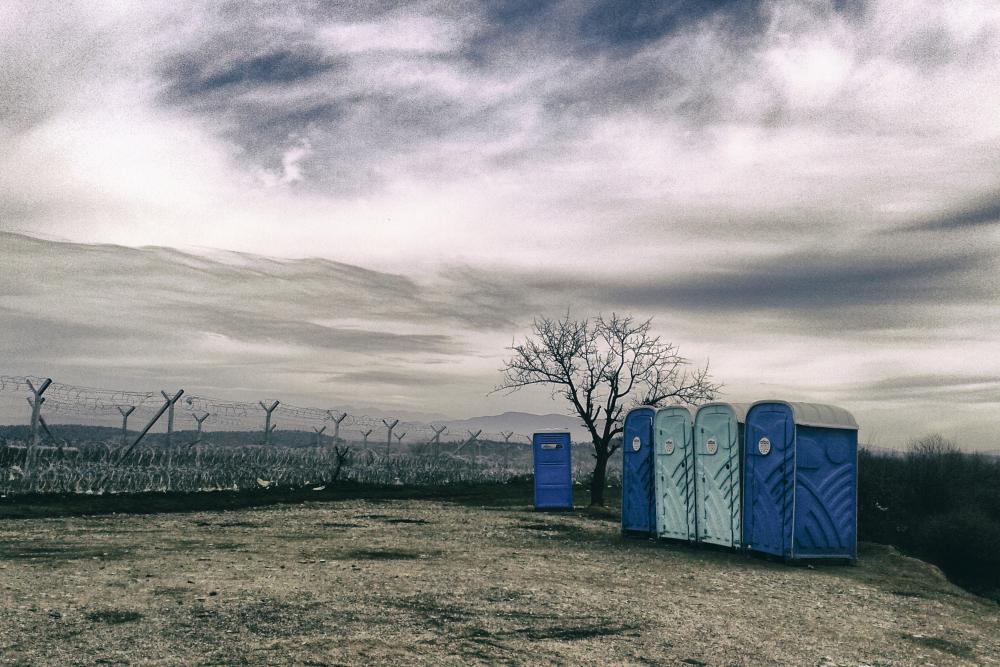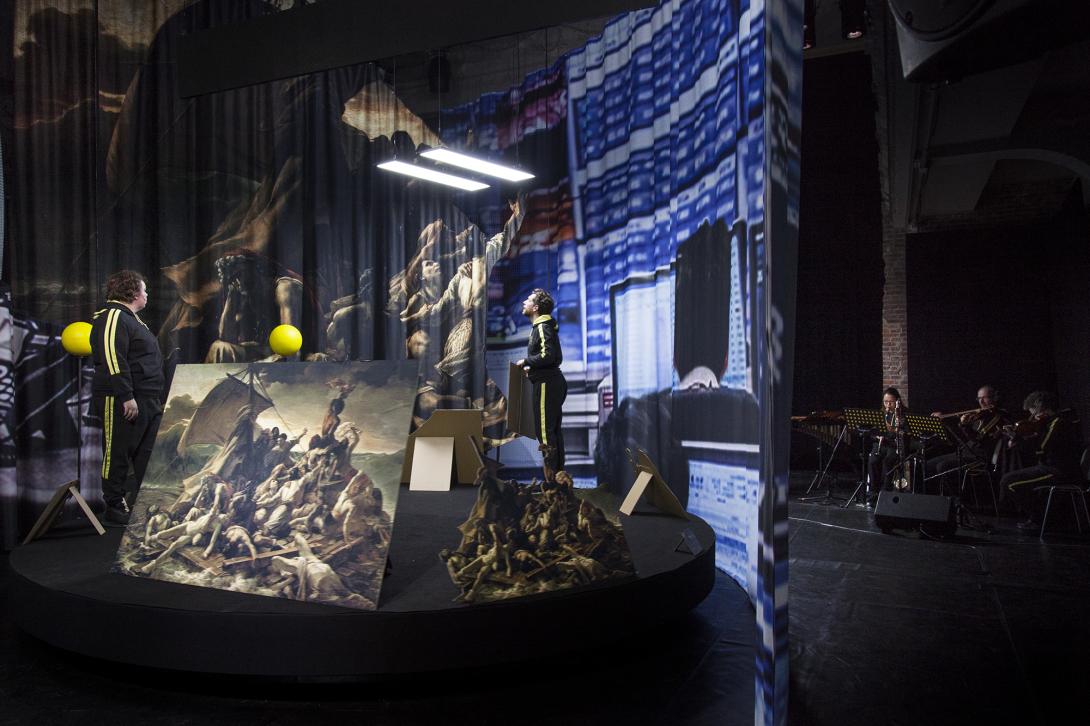If you can’t say it, you sing it, and if you can’t sing it, you dance it
A conversation with Thomas Bellinck
A conversation between Thomas Bellinck and Esther Severi (Kaaitheater, 2017)
In Simple as ABC #2, you concentrate on migration management in what you call ‘the Western migration machine’. How do you define that term?
I adopted the term from the discourse around migration, but I disagree with it. It relates to the politics of migration. Over the last few years, a tremendous shift has occurred in the migration debate from politics or policy to management. This increasingly means that humanitarian issues are treated with a form of pragmatism. Migration policy is then reduced to the question: how do you manage the movement of so many bodies across space and how do you do so as efficiently as possible? The question is of course what selection mechanisms underlie all this management, which implies much more than merely ‘directing traffic’. The result is social selection: which bodies are desirable and which bodies are undesirable…
You talk about migration and migrants in relatively abstract terms: as bodies that move across space. In the performance, you refer to data subjects: subjects that are registered at the border and then exist as a collection of ‘data’. Can this abstract terminology encompass all people?
Frontex – the European Border and Coast Guard Agency that is regularly mentioned in news reports about the asylum crisis – doesn’t in principle deal with migration but with border control. They effectively have jurisdiction over every movement that occurs at the border. Every year, 700 million bodies move across the borders of the EU, by land, sea, and air. But Frontex was founded in 2004 with the specific purpose of counteracting what was then called ‘illegal migration’ and is now known as ‘irregular migration’. But this migration only makes up 0.14% of those 700 million bodies. The agency observes movements across the border, but primarily to detect violations. These may include things like drug trafficking or weapons trading, but one of these violations is also the unannounced movement of unwanted bodies across the border. From within this logic, ‘irregular’ migrants are automatically criminalized along with smuggled cigarettes and Kalashnikovs.
I seek to adopt the jargon of management in order to reflect on it, but at the same time, you have to guard against perpetuating a number of thought patterns. All these terms and concepts are incredibly complex. What I can attempt to do is to enhance our understanding of them within a certain pattern of thought and then to elaborate on them using other possible perspectives and frameworks.
‘Data subject’ is another of these terms that circulates in official documents. Some policymakers use the term while others do not, which is indicative of the huge discrepancy you sometimes see between published policy documents and the realities on the ground. But these words have entered circulation. To me, the term data subject refers to a strange paradox that concerns the objectifying tendency to reduce people to legible surfaces of data, but your personal data makes you extremely subjective as a human being. Migration policy is full of this paradoxical tension between the objective and the subjective. Irregular migrants are generally considered to be one group, which is expressed for example in representations of ‘the migrant’ in the West. On the other hand, you are labelled irregular on the basis of hyper-subjective data, which include not only your country of origin, as in the past, but also your wealth, income bracket, and personal profile.
You conducted a whole series of discussions with migration policymakers, people involved in what you call the apparatus, machine, or dispositive. How do you move from understanding their jargon to representing it on stage?
I have always been interested in discourse analysis – not only in what people say but also in the way they say it. That is why my work is based on intensive documentary research. Even only in interviews, of example, the way people talk about things, their hesitations and repetitions, can tell you a lot about their attitudes to the subjects they are discussing.
I gradually started noticing that on the issues of migration and migration management, there is an enormous production and circulation of images. These images are both verbal and visual: words like ‘migration streams’, ‘migration waves’, photos of a lot of people packed onto tiny boats, people clambering over fences, large crowds of people snaking along roads. Among policymakers, many of these images are created in the course of things and adopted by the apparatus as a whole. ‘Apparatus’ is itself an ambiguous term: using it is risky because it seems to indicate a single body, while it is actually a network consisting of biological contributors, machines, various organizations, etc.
The interesting thing about the word apparatus – and the way this word structures your material in your artistic practice – is that it refers to a single perspective. You create a metaphor: a machine that operates according to a certain logic, which is simply perpetuated once the machine is set in motion.
The term network is indeed too noncommittal for what I aim to do in the performance; it lacks the intentionality of apparatus. I am fascinated by the way the Italian philosopher Giorgio Agamben talks about the apparatus or the ‘dispositive’. He refers to tension between three things: the creator of the apparatus, the purpose it serves, and the moment that the apparatus takes control. He claims that the world is divided into living beings and apparatuses. The apparatuses were created by the living beings at some point, but the living beings are now confined by the apparatuses, which leads to a struggle to break free from the apparatus. For Agamben, a mobile phone might be an example of such an apparatus: an object created with a certain purpose. This purpose still exists, but at a certain point, the apparatus takes over and as a human being, you are subjected to its consequences. The apparatus is not only the appliance as such that you use to ring people, it is also includes the changes in your behaviour that its use brings about, child labour in cobalt mines, the fear of harmful radiation, etc. You cannot simply remove yourself from the apparatus, but you cannot simply accept it uncritically either. Where is the middle ground? How can you make the apparatus visible and expose the way it operates, and then attempt to intervene?
What is the difference between the documentary material that you collected as an interviewer and the interpretation of this material in the production? How does the material start behaving within your own story?
I usually start from a documentary reality. I record conversations, but I consider them to be malleable material that I can mould and fictionalize. I strive to be as transparent as possible in the way I fictionalize things, both towards the viewers and the people I interview. When I speak to people, I am open about what I intend to do with the material. If possible, I attempt to develop long-term conversations, such as with Frontex for example. In 2015, I made Simple as ABC #1: Man vs Machine within the production Infini by Jozef Wouters, who is now also collaborating with us on the set design. Simple as ABC #1 was a short theatrical essay about migration high-tech for which we reconstructed the Frontex ‘situation room’ as a set. I sent them photos of the sets. For Simple as ABC #2, I suggested that we devote ten minutes of the new performance to them, for which I would make my whole team available. Ultimately, they did not agree to this specific suggestion, but it did lead to a conversation in which they suggested creating a scene of a rescue operation. Our conversation about this scene is in the finished production.
Furthermore, I always respect everybody’s anonymity. I remove all the references to specific agencies and institutions from the production so that you do not know who represents which institution. I change the names of people that I speak to or omit their names entirely. I actually try to separate the material from the people themselves to produce a symphony of voices, a polyphonic apparatus that occasionally splutters and contradicts itself.
Early in the process, you chose to turn part of the production into a musical. It is actually the section in which the apparatus, the machine, takes centre stage. Why did you choose this form?
Choosing to make it a musical was initially very intuitive. The result of working with documentary material is that I am always searching for the kind of narrative we need to relate to our complex reality. A reality that can no longer rely on causal, linear narratives or metaphorical characters. Musical is a dramatic genre that detaches form and content in interesting ways. When you set something to music, you are immediately detached from a kind of naturalism.
There is a fascinating quip in the musical genre: If you can’t say it, you sing it, and if you can’t sing it, you dance it… This intrigues me because within the documentary form, I sometimes miss the potential for transformation. The documentary form often has an unmasking reflex that is predominated by the pedagogical and informative: “We will show you the truth behind…” By contrast, I seek to present something imaginary, something speculative. Something that might shift perspectives, rather than replacing one dominant narrative with yet another truth claim.

